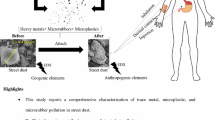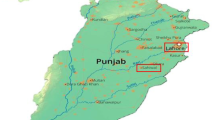Abstract
Microplastics (MPs) are ubiquitous in our environment. Its presence in air, water, and soil makes it a serious threat to living organisms and has become a critical challenge across ecosystems. Present study aimed to assess the abundance of MPs in aerosols and street dust in Varanasi, a typical urban city in Northern India. Airborne particulates and street dust samples were collected from various sampling sites around Varanasi City. The physical identification of MPs was conducted by binocular microscopy, fluorescence microscopy, and scanning electron microscopy (SEM), while elemental analysis was made by energy-dispersive X-ray (EDX). Finally, Fourier-transform infrared spectroscopy (FTIR) was used for chemical characterization of MPs. Presence of MPs in both aerosols and street dust from all selected sampling sites was confirmed, however with varying magnitude. MPs of different colors having the shape of fragments, films, spherules, and fibers were recorded in the study while fragments (42%) in street dust and fibers (44%) dominated in aerosols. Majority of the MPs were < 1 mm in size and were primarily polypropylene, polystyrene, polyethylene, polyethylene terephthalate, polyester, and polyvinyl chloride types. The EDX spectra showed the presence of toxic inorganic contaminants like metallic elements on MPs, especially elements like aluminum, cadmium, magnesium, sodium, and silicon found to adsorb on the MPs. Presence of MPs in the airborne particulates and street dust in Varanasi is reported for the first time, thus initiating further research and call for a source-specific management plan to reduce its impact on human health and environment.





Similar content being viewed by others
Data availability
All data generated or analyzed during this study are included in this published article.
References
Abbasi S, Keshavarzi B, Moore F, Delshab H, Soltani N, Sorooshian A (2017) Investigation of microrubbers, microplastics and heavy metals in street dust: a study in Bushehr city. Iran Environ Earth Sci 76:1–19
Abbasi S, Keshavarzi B, Moore F, Turner A, Kelly FJ, Dominguez AO, Jaafarzadeh N (2019) Distribution and potential health impacts of microplastics and microrubbers in air and street dusts from Asaluyeh County. Iran Environ Pollut 244:153–164
Akhbarizadeh R, Dobaradaran S, Torkmahalleh MA, Saeedi R, Aibaghi R, Ghasemi FF (2021) Suspended fine particulate matter (PM2. 5), microplastics (MPs), and polycyclic aromatic hydrocarbons (PAHs) in air: their possible relationships and health implications. Environ Res 192:110339
Badola N, Bahuguna A, Sasson Y et al (2022) Microplastics removal strategies: a step toward finding the solution. Front Environ Sci Eng 16:7
Browne MA, Crump P, Niven SJ, Teuten E, Tonkin A, Galloway T, Thompson R (2011) Accumulation of microplastic on shorelines woldwide: sources and sinks. Environ Sci Technol 45(21):9175–9179
Cai L, Wang J, Peng J, Tan Z, Zhan Z, Tan X, Chen Q (2017) Characteristic of microplastics in the atmospheric fallout from Dongguan city, China: preliminary research and first evidence. Environ Sci Pollut Res 24:24928–24935
Catarino AI, Macchia V, Sanderson WG, Thompson RC, Henry TB (2018) Low levels of microplastics (MP) in wild mussels indicate that MP ingestion by humans is minimal compared to exposure via household fibres fallout during a meal. Environ Pollut 237:675–684
Chauhan JS, Semwal D, Nainwal M et al (2021) Investigation of microplastic pollution in river Alaknanda stretch of Uttarakhand. Environ Dev Sustain 23:16819–16833
Christie RM (1994) Pigments, dyes and fluorescent brightening agents for plastics: an overview. Polym Int 34:351–361
Chubarenko I, Esiukova E, Bagaev A, Bagaeva M, Grave A (2018) Three-dimensional distribution of anthropogenic microparticles in the body of sandy beaches. Sci Total Environ 628:1340–1351
Dehghani S, Moore F, Akhbarizadeh R (2017) Microplastic pollution in deposited urban dust, Tehran metropolis. Iran Environ Sci Pollut Res 24:20360–20371
Dris R, Gasperi J, Saad M, Mirande C, Tassin B (2016) Synthetic fibers in atmospheric fallout: a source of microplastics in the environment? Mar Pollut Bull 104:290–293
Enyoh CE, Verla AW, Verla EN, Ibe FC, Amaobi CE (2019) Airborne microplastics: a review study on method for analysis, occurrence, movement and risks. Environ Monit Assess 191:1–17
Kumari S, Jain MK, Elumalai SP (2021) Assessment of pollution and health risks of heavy metals in particulate matter and road dust along the road network of Dhanbad, India. J Health Pollut 11
Lei L, Hui Q, Lifeng W (2006) Influences of fluorescent whitening agent on whitening effect in plastic. Plast Sci Technol 35:80–85
Li H, Qian X, Wang Qg (2013) Heavy metals in atmospheric particulate matter: a comprehensive understanding is needed for monitoring and risk mitigation. ACS Publications
Liu K, Wang X, Fang T, Xu P, Zhu L, Li D (2019) Source and potential risk assessment of suspended atmospheric microplastics in Shanghai. Sci Total Environ 675:462–471
Masiá P, Sol D, Ardura A, Laca A, Borrell YJ, Dopico E, Laca A, Machado-Schiaffino G, Díaz M, Garcia-Vazquez E (2020) Bioremediation as a promising strategy for microplastics removal in wastewater treatment plants. Mar Pollut Bull 156:111252
Mohanraj R, Azeez P, Priscilla T (2004) Heavy metals in airborne particulate matter of urban Coimbatore. Arch Environ Contam Toxicol 47:162–167
Narmadha VV, Jose J, Patil S, Farooqui MO, Srimuruganandam B, Saravanadevi S, Krishnamurthi K (2020) Assessment of microplastics in roadside suspended dust from urban and rural environment of Nagpur, India. Int J Environ Res 14:629–640
Patchaiyappan A, Dowarah K, Ahmed SZ, Prabakaran M, Jayakumar S, Thirunavukkarasu C, Devipriya SP (2021) Prevalence and characteristics of microplastics present in the street dust collected from Chennai metropolitan city. India Chemosphere 269:128757
Pauly JL, Stegmeier SJ, Allaart HA, Cheney RT, Zhang PJ, Mayer AG, Streck RJ (1998) Inhaled cellulosic and plastic fibers found in human lung tissue. Cancer Epidemiol Prev Biomarkers 7:419–428
Prata JC (2018) Airborne microplastics: consequences to human health? Environ Pollut 234:115–126
Prata JC, da Costa JP, Lopes I, Duarte AC, Rocha-Santos T (2020) Environmental exposure to microplastics: an overview on possible human health effects. Sci Total Environ 702:134455
Rocha-Santos T, Duarte AC (2015) A critical overview of the analytical approaches to the occurrence, the fate and the behavior of microplastics in the environment. TrAC, Trends Anal Chem 65:47–53
Sol D, Laca A, Laca A, Díaz M (2020) Approaching the environmental problem of microplastics: Importance of WWTP treatments. Sci Total Environ 740:140016
Sol D, Laca A, Laca A, Díaz M (2021) Microplastics in wastewater and drinking water treatment plants: occurrence and removal of microfibres. Appl Sci 11:10109
Sol D, Laca A, Laca A, Díaz M (2022) Wastewater treatment approaches to remove microplastics: microfibre incidence and fate, Polluting Textiles. Routledge, pp. 153–184
Teuten EL, Rowland SJ, Galloway TS, Thompson RC (2007) Potential for plastics to transport hydrophobic contaminants. Environ Sci Technol 41:7759–7764
Teuten EL, Saquing JM, Knappe DR, Barlaz MA, Jonsson S, Björn A, Rowland SJ, Thompson RC, Galloway TS, Yamashita R (2009) Transport and release of chemicals from plastics to the environment and to wildlife. Philos Trans R Soc b: Biol Sci 364:2027–2045
Verla AW, Enyoh CE, Verla EN, Nwarnorh KO (2019) Microplastic–toxic chemical interaction: a review study on quantified levels, mechanism and implication. SN Applied Sciences 1:1–30
Zhou Q, Tian C, Luo Y (2017) Various forms and deposition fluxes of microplastics identified in the coastal urban atmosphere. Chin Sci Bull 62:3902–3909
Funding
TB acknowledge financial support from Banaras Hindu University under Institute of Eminence grant (6031).
Author information
Authors and Affiliations
Contributions
Tirthankar Banerjee and Jaspal Singh Chauhan designed the work. Dipika Pandey conducted the research and analysis. Dipika Pandey and Neha Badola wrote the manuscript. Tirthankar Banerjee, Jaspal Singh Chauhan, Dipika Pandey, and Neha Badola participated in the interpretation of results, review, and editing of the paper.
Corresponding author
Ethics declarations
Ethical approval
Not applicable.
Consent to participate
Not applicable.
Consent for publication
Not applicable.
Competing interests
The authors declare no competing interests.
Additional information
Responsible Editor: Gerhard Lammel
Publisher’s note
Springer Nature remains neutral with regard to jurisdictional claims in published maps and institutional affiliations.
Supplementary Information
Below is the link to the electronic supplementary material.
Rights and permissions
About this article
Cite this article
Pandey, D., Banerjee, T., Badola, N. et al. Evidences of microplastics in aerosols and street dust: a case study of Varanasi City, India. Environ Sci Pollut Res 29, 82006–82013 (2022). https://doi.org/10.1007/s11356-022-21514-1
Received:
Accepted:
Published:
Issue Date:
DOI: https://doi.org/10.1007/s11356-022-21514-1




